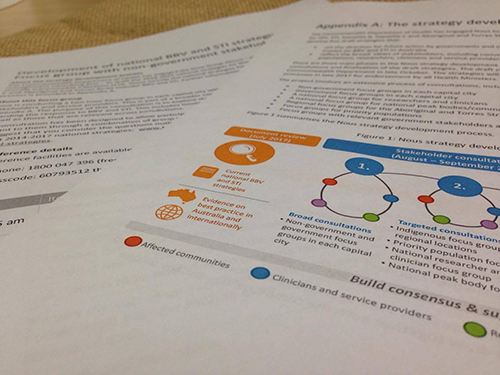CEH help shape national BBV and STI strategies

The Commonwealth Department of Health has engaged CEH as part of a focus group to consult and help shape the 2018-2022 national strategies for blood borne viruses (BBV) and sexually transmissible infections (STI). These include the national strategies for HIV, STI, hepatitis B, hepatitis C and Aboriginal and Torres Strait Islander BBV and STI.
The purpose of this consultation is to explore stakeholder’s views on key issues and priorities regarding the response to BBV and STI. As part of our contribution CEH Co-manager Alison Coehlo, former board member of Australian Federation of Aids Organisations, Chair of the Australian Multicultural BBV/STI Alliance and Chair of the International Student Health Network was there.
She outlined how CEH sees HIV as a changing epidemic, and needs to move beyond a focus on men who have sex with men. Changing migration patterns means that we need to have specifically targeted strategies to address the needs of people from refugee and migrant backgrounds, asylum seekers and mobile populations. That hidden, hard to reach communities must not be left behind in elimination efforts, the current and future targets will never be achieved if strategies continue to be limited in their reach.
Alison emphasised the greatest burden of disease is felt by our First Nations Peoples. The voices and meaningful representation of marginalised disenfranchised communities are critical for change.
Moving Forward CEH argues that data and evidence need to support any strategic actions. More investment must be provided urgently to agencies that work in partnership with affected communities. That work, in a culturally competent and health literate way, that puts communities at the centre of our approach is key to making effective change
Related Information
Connecting with communities using Health Literacy principles
Plain language is essential for effective communication. When health information is presented in plain language, it is easier for people to understand. This is particularly important when dealing with diverse communities where English may not be the first language for many residents.
Co-design: what, why and how?
We know that collaboration is an important step in engaging diverse communities in services, particularly those that face certain barriers such as linguistic and cultural differences, lack of awareness of services, and limited access to information. So, how can we collaborate with these communities? Read on for our thoughts.
The Arthur Kleinman Explanatory Model
This model was first proposed by Arthur Kleinman, who developed a set of eight questions to ask a client to learn more about their explanatory model to provide better patient-centered care.
Addressing challenges to work cross culturally; new cultural competence bundles
When there are gaps in cultural awareness and language, there are more misunderstandings, biases and sometimes compromised health outcomes. The good news is that there is so much we can do to be more prepared.

Let us inform you about our EVENTS & NEWS?
